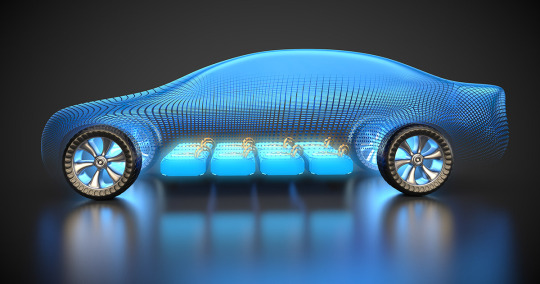#renewable electricity
Batteries have an important role as energy sources with environmental advantages. They offset the negative environmental impacts of fossil fuels or nuclear-based power; they are also recyclable. These attributes have led to increasing research with the aim of improving battery design and environmental impact, particularly regarding their end of life. In addition, there is a desire to improve battery safety as well as design batteries from more sustainable and less toxic materials.

Electric Vehicle
New research shows that aluminium battery could offer several advantages:
Aluminium metal anode batteries could hold promise as an environmentally friendly and sustainable replacement for the current lithium battery technology. Among aluminium’s benefits are its abundance, it is the third most plentiful element the Earth’s crust.
To date aluminium anode batteries have not moved into commercial use, mainly because using graphite as a cathode leads to a battery with an energy content which is too low to be useful.
This is promising for future research and development of aluminium as well as other metal-organic batteries.

Battery Charging
New UK battery project is said to be vital for balancing the country’s electricity demand
Work has begun on what is said to be Europe’s biggest battery. The 100MW Minety power storage project, which is being built in southwest England, UK, will comprise two 50MW battery storage systems. The project is backed by China Huaneng Group and Chinese sovereign wealth fund CNIC.
Shell Energy Europe Limited (SEEL) has agreed a multi-year power offtake agreement which will enable the oil and gas major, along with its recently acquired subsidiary Limejump, to optimise the use of renewable power in the area.

Renewable power
In a statement David Wells, Vice President of SEEL said ‘Projects like this will be vital for balancing the UK’s electricity demand and supply as wind and solar power play bigger roles in powering our lives.

Battery
The major hurdles for battery design, states the EU’s document, include finding suitable materials for electrodes and electrolytes that will work well together, not compromise battery design, and meet the sustainability criteria now required. The process is trial and error, but progress is being made.
For more information, click here.
Reference:
The Scottish engineer James Blyth died on May 15th 1906 in Glasgow.
Us Scots have always been innovators, wind turbines are popping up all over but when Kincardineshire man James Blyth invented a turbine to light his holiday home in Marykirk and offered to light the village street it was the work of the devil.
James Blythe was described as “a true man of science…one who by insight, patient toil, and mechanical ingenuity did much in his day to explain and illustrate many of the facts of physical science.“
Born in April 1839 in Marykirk, Kincardineshire, Blyth was educated at the local Parish school and Montrose Academy before winning a scholarship to the General Assembly Normal School in Edinburgh. After obtaining a BA from the University of Edinburgh, he taught mathematics at Morrison’s academy in Crieff.
After obtaining his MA in 1871, Blyth was appointed Freeland Professor of Natural Philosophy at Anderson’s College in 1880 (now the University of Strathclyde), where he began a research program on the use of wind power for electricity generation and storage. This research culminated in the installation of a cloth-sailed, horizontal wind turbine (as opposed to the now more common vertical wind turbine) at his Marykirk holiday cottage in July 1887.
This was several months before the American Charles F. Brush installed what many mistakenly believe to be the first wind turbine, though Brush’s was considerably larger and included the useful safety feature of an automatic brake to prevent damage in high winds. Blyth’s design was 33 ft in diameter and stored the electricity generated in ‘accumulators’, otherwise known as batteries.
After a lack of success offering his surplus electricity to local villagers, who branded electricity ‘the work of the devil’, Blyth was able to install a larger, much-improved version of his wind turbine at the Montrose Lunatic Asylum, Infirmary and Dispensary, where it ran successfully for 30 years.
In 1891 Blyth presented a paper to the Royal Society of Edinburgh espousing his belief in the benefits of renewable energy sources, particularly wind but also wave energy.
Blyth received an honorary doctorate from the University of Glasgow in 1900 and died in 1906. After the turbine at Montrose Asylum was dismantled in 1914, there would not be another public utility wind turbine in Britain until 1951. However, his legacy today is an important one, as his old college, the University of Strathclyde, conducts world-leading research into wind turbine technology and Scotland seeks to become a world leader in wind energy generation.
So that’s another first for Scotland, the wind turbine.
Post link
In terms of aesthetic, genre, and political movement, Solarpunk is very new. Anarchism has been around formally since 1809, but perhaps even before. So in terms of egalitarian ideologies, Solarpunk is the peppy, bright-eyed child in the egalitarian/collectivist political sphere, but at this point it’s our best hope in terms of getting out of the choke-hold we’ve been in for so long. Having hope in the future doesn’t make a movement less serious, it makes the people involved fight harder than those on the sidelines. Solarpunks are the scholars and players, we study and we play in our down time. I know I do at least, I have connections all across my community, even into city government and partially into county government, so pulling a few strings would be easy, but I also do things that aren’t so legal. In the spring and summer, I’m an avid guerrilla gardener and graffiti artist. Not that I’m any good at graffiti, but I get the message across in biodegradable spray paint and chalk. One of these days I’m going to talk face-to-face with our energy council and treasurer and discuss a bill to add clean rooftop energy to all the small stores in my city, but that’s just me.
What drives us is hope, we’re tired of feeling trapped under a sense of impending doom, we’re tired of feeling trapped under capitalism, and we’re tired of the evils of the world winning because it’s profitable. We’re angry, we’re smart, and we’re strong, much stronger together than any bourgeois pigs. Even if we have to work within the red tape, we will prevail because we’re working together and I think we can all get behind that goal.



